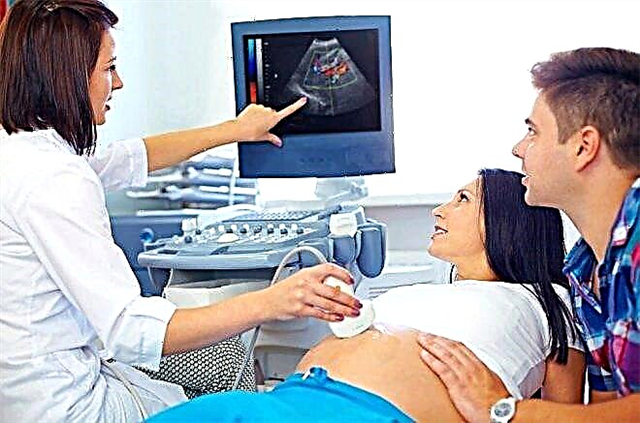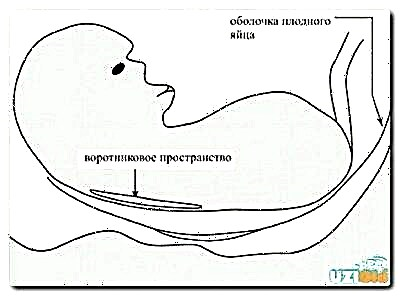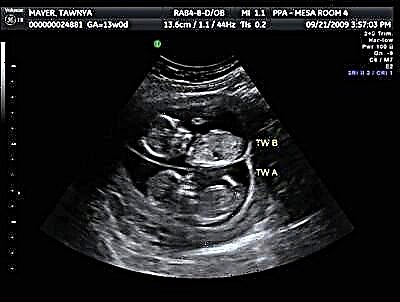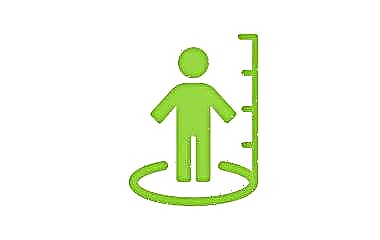
The first trimester of pregnancy ends, and with it the discomfort associated with toxicosis and hormonal changes go away. The expectant mother becomes calmer and more judicious. At 13 weeks, most pregnant women will have a long-awaited meeting with their baby for an ultrasound scan. It is this week that up to 90% of all expectant mothers receive referrals for the first prenatal screening, since this week is considered the most informative.

Objectives of the survey
Ultrasound, carried out between 11 and 13 weeks of pregnancy, is part of the complex of prenatal diagnostics, which, by order of the Ministry of Health of Russia, are carried out to all women registered in the antenatal clinic. An ultrasound scan at 12-13 weeks is considered the most important, since the fetus is no longer so small that the diagnostician can miss possible deviations in its development.
The purpose of the study is in a comprehensive assessment of the state of the crumbs, in search of markers, which may indirectly indicate possible genetic abnormalities, defects and abnormalities. The data obtained are compared with the results of a blood test, which is designed to establish the concentration of certain hormones and proteins inherent in a woman during the period of bearing a child.
Both studies calculate the potential risks of congenital abnormalities in a child. If it turns out that the risk of Down syndrome or Edwards disease is high, the woman is recommended to undergo a more accurate invasive examination, during which chorion particles from the baby's DNA are taken for analysis.

In addition to early diagnosis of defects, ultrasound at 13 weeks allows you to establish the exact timing of pregnancy, the growth rate of the baby, see the problems of gestation, the threats and risks of spontaneous abortion. The procedure this week is considered very informative, and the screening itself, carried out during this period, is the most important in the entire pregnancy.
13 weeks pregnant - these are obstetric values, which, on average, are 2 weeks ahead of the woman's own calculations... Thus, 11 weeks have passed since conception, and almost 9 weeks have passed since the day of the delay and the first "two cherished stripes".

How is the ultrasound scan, is preparation needed
An ultrasound is done at 13 weeks, most often in a transabdominal way, in which the sensor is in contact with the skin of the woman's abdomen, and the doctor receives an overview through the anterior abdominal wall. However, if the expectant mother is overweight, fat folds on the abdomen, the doctor may decide in favor of another method of examination - transvaginal.
Internal ultrasound is performed with a transducer in a condom. View through the vaginal wall is considered more accurate, therefore, it is used in all cases when there is a suspicion of the threat of termination of pregnancy, in order to examine not only the child, but also the features of the cervix, uterine walls.


No special preparation for an ultrasound scan at week 13 is required... The uterus is already large enough and the amount of water allows an examination without a full bladder. Before undergoing a vaginal ultrasound, it is generally desirable to free the bladder and intestines from the contents, and 2-3 hours before the examination, take one dose of the drug that reduces the amount of intestinal gases.
You can drink "Smecta", "Espumisan" or "Simethicon". They are harmless for pregnant women.


What can be seen during this period?
At 13 weeks, the size of the fetus is 10-12 centimeters, its weight is 20-30 grams. The child still looks disproportionate - the head still remains the largest part of his body, however, the features of his small face are already beginning to acquire individuality, the rudiments of milk teeth have formed. this week the nervous system of the baby continues to develop at a rapid pace, its movements are now controlled by the brain, and new muscle-neuronal connections are formed almost every hour.
The baby's pancreas has begun to synthesize insulin. Starting this week, the head of the baby begins to grow more slowly, but the rest of the body "accelerates". The formation of the external genitalia continues, they are already distinguishable, and under a favorable set of circumstances, the doctor on an ultrasound scan will already be able to consider the sex of the child.

The placenta has formed, and this week it takes control of the baby's life processes and nutrition. The yolk sac is thus no longer needed; it ceases to exist. On an ultrasound scan, at this time, the child shows everything he has learned over the past few weeks - he vigorously moves his arms and legs.

In response to loud sounds and unfamiliar voices, it can respond with either an increase in physical activity, or, conversely, by fading. He hears everything, knows how to distinguish the usual "safe" sounds - mother's blood flow, heartbeat, breathing and the voice of strangers, and therefore potentially dangerous - other people's voices, the buzzing of equipment, slamming the door.
On the ultrasound, the baby's heartbeat is clearly audible, and the mother must be given to listen to it. The kid every day more and more resembles a person in external parameters. The ultrasound sensor can detect and examine all of the baby's internal organs.

Decoding the results
Deciphering the results should be dealt with by specialists, however, expectant mothers are very curious and inquisitive people, and therefore very often questions are asked what the ultrasound protocol handed out can mean and is everything okay with the child. Unfortunately, the doctor does not always have time to explain to each pregnant woman what abbreviations and numerical values he uses to describe the child's condition, because screening takes place on a first come, first served basis. That is why a detailed explanation is given below.
First of all, the doctor marks the date of the last menstruation so that the obstetricians have the opportunity to calculate the expected date of birth. Then he indicates the way in which the examination was performed - transvaginal, transabdominal, or both, if the examination required the use of two methods.

This is followed by the number of fruits. If a woman is expecting twins, then the doctor notes whether there are signs of vital activity in each child. These signs include palpitations and physical activity.
The position of the child in the uterine space is also subject to description - it can be head, transverse and pelvic, at this time it does not matter, since the baby is still free and spacious in the mother's womb, and it is constantly spinning, tumbling and changing its position.

From week 13, doctors no longer measure the coccyx-parietal size, it is no longer considered informative. More useful data is now called fetometric. These are BPD (biparietal head size - the segment between the temporal bones), LZR (frontal-occipital size - the segment from the frontal to the occipital bone), as well as the length of the paired bones - the femur, shin bone, forearm and humerus.
Not all of these measurements can be practically done at 13 weeks. The table of normal fetometry values at 13 weeks (12-13 weeks) is as follows:

The baby's abdominal circumference at this time is on average from 61 to 69 mm. The yolk sac, like the CTE of the fetus, is no longer measured this week. Heart rate rates averaged between 147 and 171 beats per minute this week. Markers such as the thickness of the collar space and the length of the nasal bones are important for diagnosing possible genetic abnormalities. These parameters are assessed once during the first ultrasound screening. The table of TBP and length of the nasal bones at 13 weeks is as follows:

The amount of amniotic fluid at this time is not measured. In addition to the development of the child, the doctor describes the features of women's health - the size of the uterus, ovaries, the state of the fallopian tubes and other indicators.
Sex determination is not included in screening, and therefore this service will be paid. It should be noted that the probability of an error in determining gender at this time is quite high - boys are confused with girls if they cover their genitals with their legs, and girls can be easily mistaken for boys if the umbilical cord passes between the legs.
Therefore, at 13 weeks, doctors do not speak with confidence about the sex of babies; more accurate answers to an important question for parents can be obtained at the next examination, which is carried out from 18 to 21 weeks.

Possible problems
Ultrasound problems can reveal a wide variety. At this time, taking into account the specifics of the examination, most often expectant mothers find themselves in confusion and panic due to the discrepancy between the size of the baby's head and the obstetric period of pregnancy, as well as because of dubious results in identifying markers of chromosomal abnormalities.
If BPD and LHR of the fetus are significantly less than the norm, doctors may talk about intrauterine growth retardation, as well as that the child may have genetic abnormalities. Exceeding the size of the head - also needs a separate medical "investigation". It is possible that there was an error in establishing the timing of pregnancy - this often happens in women with an irregular menstrual cycle, with late ovulation.

An increase in the thickness of the collar space, as well as the absence of nasal bones, which is shown by ultrasound - reason to go to genetics, as well as conducting a control ultrasound study in about a week.
At 13 weeks, it is believed that the period, which is dangerous in terms of the likelihood of an early miscarriage, is already behind. However, the diagnostician can still see an increased tone of the uterine walls, and then the obstetrician will prescribe treatment for the woman to maintain the pregnancy.
The revealed low placentation does not represent a serious problem at this time, because the uterus has yet to grow, and together with its walls, the placenta is likely to "migrate" higher.


Pictures
Ultrasound images at 13 weeks will allow a mother to examine her baby in more detail in a calm home environment. She will be able to see the profile of the baby, his chest and tummy, the structure of the brain.
On a three-dimensional ultrasound, you can already see a tiny man more holistically, imagine how he looks. Twins during this period look like this.

In order to preserve the image of the baby for a long time in family memory, it is better to ask the doctor for an electronic copy, on any digital medium, since the printed images quickly fade.

You can see what happens to the mother and baby at the 13th week of pregnancy in the next video.



